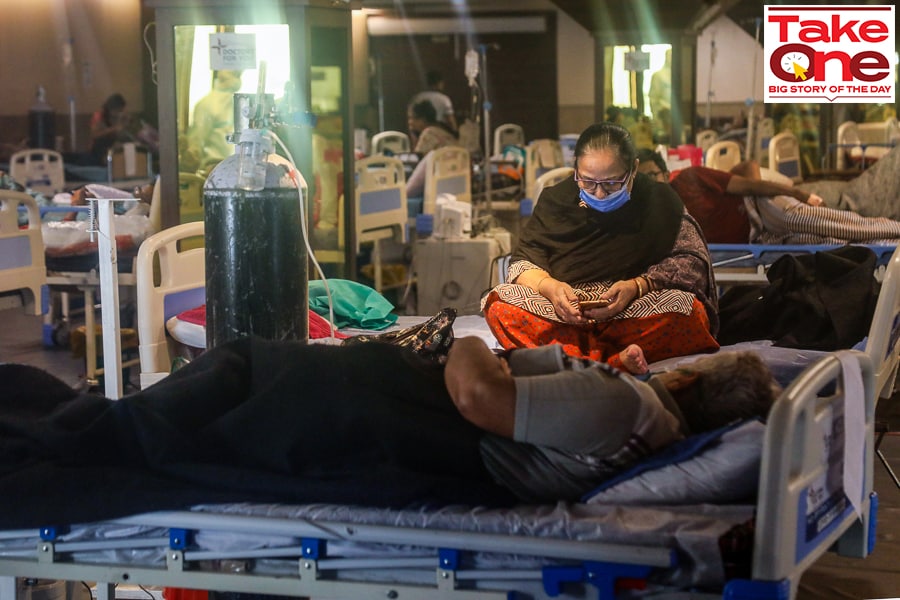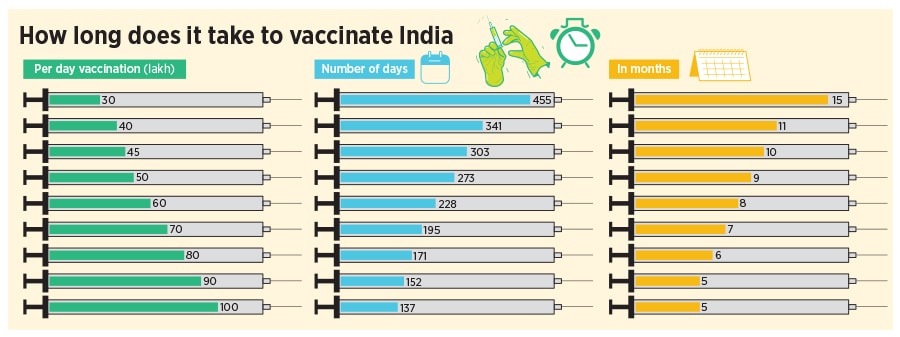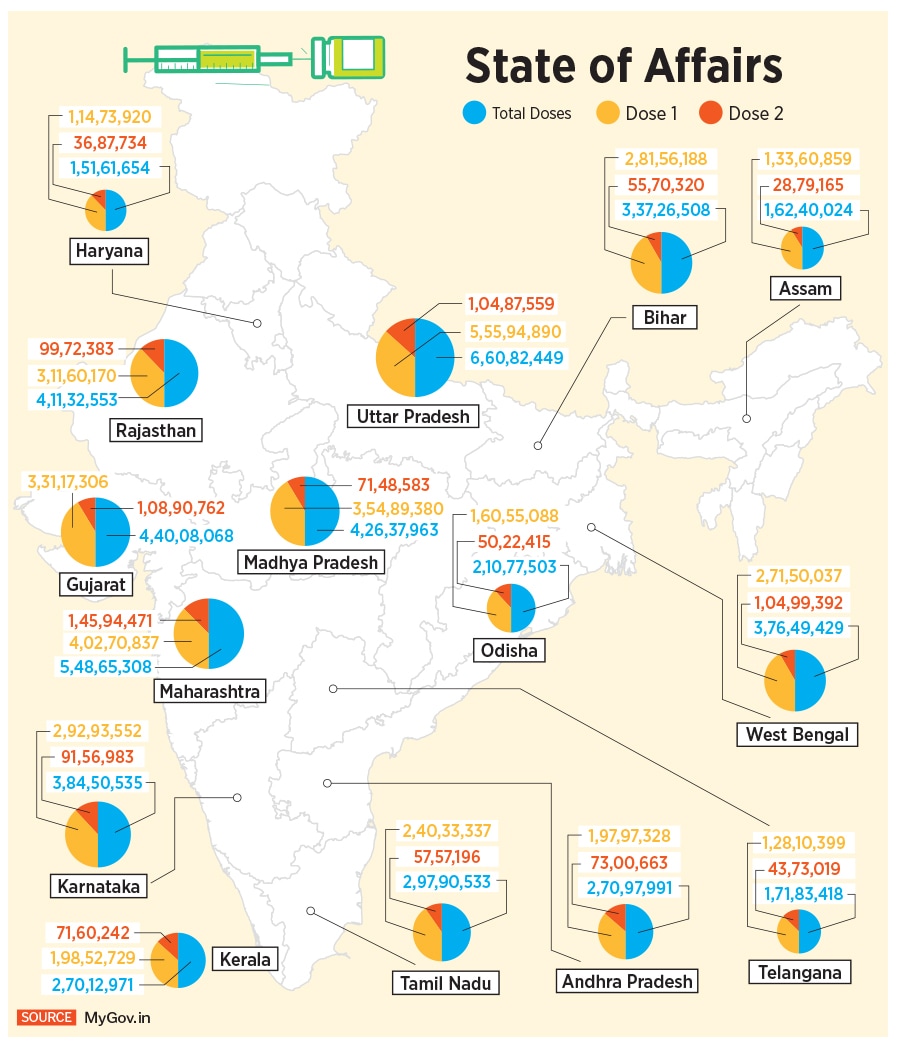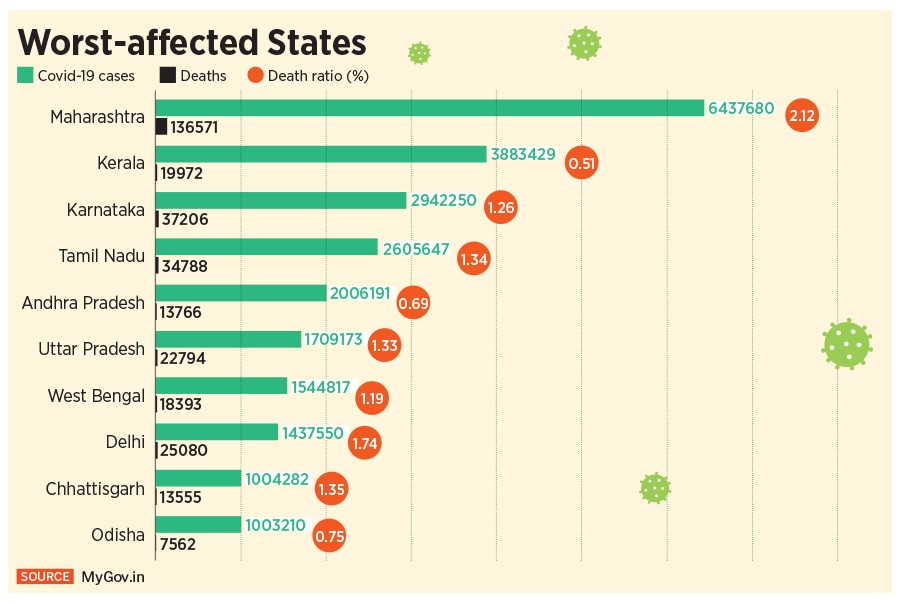That’s what an expert committee constituted by the home ministry believes could happen between September and October. The world’s second-worst Covid-19 affected country after the US could see as many 6 lakh daily cases a day, a little more than what it saw during the peak of the deadly second wave in May.
“Epidemiologists predict a series of surges till we achieve herd immunity through infection or vaccination and the disease becomes endemic," the report by the committee said in its report dated August 2 to the prime minister’s office. “Earlier, it was proposed that if 67 percent of the population became immune, herd immunity could be achieved. But this has now been complicated by the new and more virulent mutated variants of SARS Cov-2 that can escape immunity from earlier infections and in some cases even the prevalent vaccines. This has pushed the target immune population for achieving herd immunity to 80 to 90 percent."
That’s a tall ask considering India has managed to only vaccinate 14 percent of its population above the age of 18 with two doses of vaccine. As much as 48 percent of the target 94 crore adult population, however, has received a single dose. Of this, as many as 87 percent has received the Serum Institute of India’s Covishield vaccine while the remaining 13 percent got Bharat Biotech’s Covaxin. In all, the government intends to use about 188 crore doses of vaccine between January and December this year, to inoculate the population.
While the government has granted permission to four other vaccines, including Sputnik V, Johnson & Johnson, ZyCov-D and Moderna, over the past few months, Covishield and Covaxin continue to corner the lion’s share of the total vaccinations. The Russian Direct Investment Fund (RDIF), the sovereign wealth fund of Russia, had firmed up plans to produce over a billion doses of the Sputnik V vaccine in India. So far, only about 4 million [40 crore] doses of the Sputnik V have been administered in India.
“A large number has received only one dose of the vaccine and a lot more are unvaccinated. So the third wave can be a pandemic of the unvaccinated," says Dr Gopi Krishna Yedlapati, consultant interventional pulmonologist at Yashoda Hospitals, Hyderabad. “Drawing lessons from the first and second waves of the pandemic, both citizens and the government should fold up their sleeves for this imminent danger lurking around us."
According to him, hastening vaccine access and coverage, and tackling vaccine-related hesitancy, must be the top-most priorities of the government at this point. “The role of the government to achieve its target of vaccinating 940 million [94 crore] people is possible when there is a continuum of the influx of vaccines, and bridging the gap between rural and urban population and also the gender gap," he says. It also means, the doctor says, adding incentive to both urban and rural communities to encourage vaccination and reduce vaccine hesitancy by providing social education in local languages via communications with the local authorities and rural leaders.
Last week, India also approved the indigenously developed ZyCov-D vaccine, the world’s first DNA vaccine. The ZyCoV-D is a three-dose vaccine which can also be given to adolescents in the 12-18 age group, besides the adult population. ZyCoV-D is a needle-free vaccine, and the company intends to start supply of its vaccines by the end of September, with production capacity rising to 10 million [1 crore] doses a month in October. Bharat Biotech is also in Phase 3 trials with its Covaxin for children between 2 and 17 years of age. The results are yet to be announced.
“The R-value, which is the reproduction rate of Covid-19 in India, has increased from 0.96 to 1 over the few last days of July and has been flagged as a matter of concern by AIIMS," the report says. “R-value measures the number of people that are being infected by one Covid-positive person on an average."
According to the Harvard Global Health Institute, the R-naught represents, on average, the number of people that a single infected person can be expected to transmit the disease to, or the average “spreadability" of an infectious disease. If the value declines, the infection will eventually stop spreading because there will not be enough new cases for the outbreak to continue. “Kerala—that is reporting the high daily caseload of Covid-19 infections (over 20,000 cases daily)—is currently showing an R-value of 1.11," the report says. “This indicates that a third wave is upon us, and these indicators must not be ignored."
Dr KR Antony, a consultant of public health, child survival and development in Kochi, Kerala, says the spread of the coronavirus during the third wave can happen in two ways. First, the conventional virus itself reaches susceptible hosts in remote areas and small towns that are densely populated, which will lead to a spike. Second, those who are infected already and have developed antibodies will be attacked by new variants.
“Mutation strains have evolved and have to be tackled," he says, explaining that the virus finds smart ways of avoiding human resistance, which is a natural survival technique for any organism. This coronavirus will find new ways and means of survival, of learning how to beat the antibody mechanism and enter the host body. “This is how, after viruses mutate, [they become] variants of concern. Such newer variants can make a third wave."
![]()
The only way, the expert committee reckons the possibility of some reprieve, will be through aggressive vaccinations. “According to a recent study done by professors and alumni from Pandit Deendayal Energy University (PDEU) in collaboration with Nirma University, the vaccination rate of India is currently 3.2 percent, which if does not improve, can result in the country witnessing 6 lakh cases per day in the next (third) wave," the report says. “But if the government’s proposal to increase this rate by five times (1 crore doses per day) comes to fruition, India will see only 25 percent of the cases (seen in the second wave) during the third wave peak."
India achieved the target of 13.5 crore vaccine doses in July, inoculating an average of 43,41,373 doses per day, which is a 12.5 percent increase against June"s 11,96,69,381 jabs. The country has vaccinated nearly 13 crore people as of August 25. “If we go by the present vaccination rate of 45 lakh per day, the critical mass (70 percent) may be covered by a first dose by the end of November and the second dose by March 2022," a recent report by the State Bank of India, India’s largest public sector bank, says.
Children at risk? Not enough evidence, experts say
Meanwhile, much of the possibility is that a third wave could come as a result of the Delta-plus variant.
“The Delta-plus variant formed due to the mutation in the B.1.617.2 (Delta variant) that drove the fatal second surge in India," the report says. “This new variant of concern is a sub-lineage of the Delta variant that has acquired a spike protein mutation ‘K417N’ which is also found in the Beta variant (first detected in South Africa). Three patients have succumbed due to this variant so far in India, one an octogenarian with comorbidities (Maharashtra) and two unvaccinated (Madhya Pradesh)."
The Delta-plus variant has an increased transmissibility, stronger binding in receptors of lung cells and a potential reduction in monoclonal antibody response. As of August 2, the variant has been detected in 70 cases across 16 states from the 58,240 samples that have been sequenced so far in India. The health ministry has categorised this Delta-plus variant B.1.617.2.1 of SARS-Cov-2 as a ‘Variant of Concern (VOC)’.
“Genomic studies will help us know the evolving mutant strains, whether they are in the same family or totally different strains," says Dr Antony. He believes that genome sequencing is all the more important in the states of Maharashtra, Kerala, Tamil Nadu, and to some extent, in Karnataka, where, in spite of high immunisation, Covid-19 cases are increasing.
![]()
With the first wave of Covid-19 affecting the elderly, and the devastating second wave affecting younger people, concerns continue to be raised over the impact on those below the age of 18, who are yet to be vaccinated. Children with Covid-19 infection have largely been seen to be asymptomatic or develop mild symptoms.
“But this becomes worrisome in case children have any comorbidity or other special needs," the report added. “According to the ministry of health and family welfare, out of all the children hospitalised due to Covid, 60 to 70 percent had comorbidities or low immunity. Children have also been seen to develop MIS-C (Multisystem Inflammatory Syndrome) which is a rare but extremely serious condition developed post Covid recovery."
All that means that adequate infrastructure to treat children in the country could be stretched if the situation becomes dire. “Paediatric facilities—doctors, staff, equipment like ventilators, ambulances etc—are nowhere close to what may be required in case a large number of children become infected," the report adds. According to a parliamentary standing committee report in 2015, there is an 82 percent shortage of paediatricians in India’s primary health centres and up to 62.8 percent of positions for paediatricians in community health centres were vacant."
That said, Dr Antony, who has worked with the United Nations Children’s Fund (Unicef) as a health and nutrition specialist, points out that there is no statistical evidence yet to believe that more children will be impacted as a result of the third wave. “Only 12 percent of total Covid-19 cases in India so far have been children, and the mortality rate is less than 3 percent," he says, explaining that children below 5 years of age occupy 9.9 percent of India’s population of 136 crore people, while the 5-18 age group is about 27.3 percent.
“And this age group does not develop much complications even after contracting Covid-19. Deaths in this age group are low world over, even in the US," Dr Antony says. “So there is not much of a strong case to urgently pursue child immunisation. The focus needs to be on people over 60 years of age—that is a high-risk group—followed by the working population and the younger population in the 18-45 age group, which are productive years. You finish all those immunisation targets and then think about children, otherwise our attention gets divided".
Dr Sumana Arora agrees. The vice president, clinical services at DayToDay Health India, a telemedicine service, believes that right now, it is difficult to say decisively whether or not the third wave will affect children, but the “possibility cannot be ruled out". According to her, so far, India has neither seen a spike in paediatric infections, nor in paediatric hospitalisations. “We have seen cases of MIS (multiple inflammatory syndrome)," she says, adding that it would be prudent to get doctors and nurses upskilled in paediatric case management, even though it may not be as simple as it appears. “We have to make the best use of the resources that we have, even if it means upskilling adult nursing staff and adult intensivists in paediatric care, just in case their services are required."
Dr Arora says the US has seen a 500 percent rise in paediatric hospitalisations due to Covid-19 infections since early July, while data emerging from a study in Canada shows that children affected by the Delta wave might be twice at risk of hospitalisation. “Though India has witnessed infections due to Delta variants, there is inadequate data as to whether the variant causing this in the West has sub-speciated," she says.
![]()
The expert committee, in its report, reckons that a holistic home care model, immediate increase in paediatric medical capacities and prioritising mental health issues among children is the need of the hour with Covid wards being structured in a way that allows children’s attendants to safely stay with them through their recovery.
Much of that is also taking cue from the deadly second wave that gripped India earlier this year, when medical infrastructure was left wanting. “The second wave placed an unprecedented strain on the health care system with shortage of medical oxygen due to unanticipated demand, delays in transport, lack of cryogenic tankers, overburdening the health care workers working more than 24 hours without breaks, lack of availability of life-saving drugs, families and relatives of Covid-19 patients running from pillar to post trying to search for supplies in order to save their loved ones," the report says.
Dr Yedlapati says the government has to concentrate on Graded Action Plans to alleviate the situation in the event of increasing caseloads. It would also be necessary to stockpile essential drugs, particularly steroids, oxygen, antivirals, antibiotics, and antifungals that were deficient in the second wave, apart from essential medical equipment like ventilators.
“The Covid taskforce suggested the government be prepared for 23 percent hospitalisations," he says. So, the government should also be prepared for enhancing the bed strength proportionately for Covid cases, that is non-oxygen beds, non-ICU oxygen beds and ICU bed strength. People, he adds, must follow Covid-appropriate behaviour like wearing masks, washing hands regularly and maintaining physical distance.
Don’t rush with the booster shots
As the possibility of a third wave looms, questions about booster shots have been doing the rounds. Much of that is because India’s health care workers had received their shots in early January as the government opened up vaccinations.
Cyrus Poonawalla, chairman of the Serum Institute of India that manufactured Covishield, recently said that a booster dose is needed six months after the second jab as the level of antibodies go down. Poonawalla, along with employees of Serum Institute of India, have taken the third jab. In April, Bharat Biotech also got permission from the Drug Controller General of India to conduct trials for the third shot of Covaxin to be administered as a booster dose. The case for booster doses has also been built because of the emerging variants of the coronavirus.
Experts say while booster doses will be important, the focus should be on increasing basic vaccination coverage first. “It is imperative that baseline doses are given first to the general public before considering booster shots," says Dr Arora.
The World Health Organization (WHO) has said there is no need for a booster shot of Covishield in India as of now. The interim guidance was developed based on the advice issued by the Strategic Advisory Group of Experts on Immunization (SAGE) on February 8, which was updated on April 21 and July 30. The need and timing of booster doses will be evaluated as further data accumulates, the WHO said.
Given that the number of people who are fully vaccinated is comparatively small, giving a booster shot to that group might benefit minimally when looked at the larger outset, says Dr Yedlapati. The need for booster doses in India, he explains, would be decided by the epidemiology of the coronavirus, the durability of the current vaccinations and consideration of adverse events of the booster shot. “As the science in this area is still emerging, we should concentrate on the improvement of vaccination in those sets of people who haven"t received it yet," he says.
Dr Antony points out that officials and experts must admit that accuracy and reliability of data modelling exercises are often restricted by the quality of input data and unpredictability of the virus, so in terms of preparedness for the third Covid-19 wave, it is important to first ensure better access and coverage of vaccination, and capacity-building to improve the production and supply of vaccine doses.
These predictions, like the one highlighted by the NIDM report, are based on mathematical models, which can give an indication as to the occurrence of new waves. “However, these are only estimates and it is impossible to predict with absolute certainty when the next wave would hit," says Dr Arora. “We have seen that historically, third waves are seen to be milder. However, it is advisable to keep in mind that expecting to predict anything with 100 percent accuracy would be imprudent."
All this boils down to how India manages to build up, on priority, basic preparedness of public health systems. “Still, you are not making every primary health care centre connected to a strong tertiary health care centre, like district hospitals equivalent to medical colleges at the district level," points out Dr Antony.
When it comes to Covid-19 vaccination coverage strategies, basic systemic preparedness would involve active investment in bridging the immunisation gap between rural and urban India, and overcoming digital divide, by organising more camps near villages to make immunisation sites accessible, says Dr Yedlapati.
“The government has been doing a pretty good job in vaccinating adults in the urban sector, but it is facing a lot of hurdles when it comes to rural India, as most people are illiterate and lack knowledge in smartphone usage to book appointments for vaccination," he says.
According to Dr Yedlapati, the government must devise strategies to provide financial or non-financial incentives and organise on-site vaccination near villages to assure daily wage workers or poor families that they will be compensated if they miss a day’s work while getting vaccinated. “Developing an equitable and transparent health care system that works for the masses may be the only solution to stop or prevent the impact of this pandemic," he says.
A third wave might be inevitable. But preventive measures and preparedness can certainly stop a repeat of the tragic scenario that India saw a few months ago.

 Image: Naveen Sharma/SOPA Images/LightRocket via Getty Images"‹[br]
Image: Naveen Sharma/SOPA Images/LightRocket via Getty Images"‹[br]

